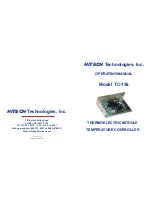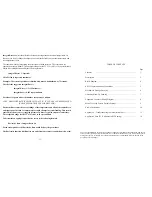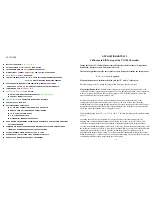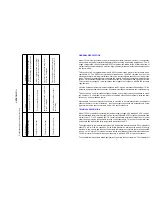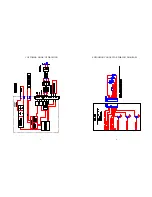
•••••
INPUT VOLTAGE FROM
12 TO 28 VOLTS DC
•••••
SELF-CONTAINED, 0.1 TO
25 AMPERE
LOAD RATING
•••••
PC PROGRAMMABLE VIA
RS232
COMMUNICATIONS PORT
•••••
BI-DIRECTIONAL CONTROL FOR
HEATING
AND
COOLING
APPLICATIONS
•••••
SOLID STATE “H” BRIDGE
OPERATION
•••••
CONTROL TEMPERATURE OF
-20°
TO
100°
C WITH TS67 SERIES THERMISTOR SENSORS
-40°
TO
70°
C WITH TS141 SERIES THERMISTOR SENSORS
•••••
PROPORTIONAL (P), INTEGRAL (I), AND DERIVATIVE (D) CONTROL THAT CAN BE
SELECTED AS P, PI, PD, OR PID; ON/OFF WITH AN ADJUSTABLE HYSTERESIS
•••••
TEMPERATURE
RESOLUTION OF 0.05°C.
•••••
PULSE WIDTH MODULATION
OF OUTPUT
•••••
SELECTABLE MODULATION FREQUENCY OF
675 Hz OR 2700 Hz
•••••
CONTROL STABILITY OF ±0.05°C.
•••••
1500 VAC ISOLATION
OF RS232 COMMUNICATIONS INTERFACE
•••••
CONTROLS UP TO 680 WATTS
•••••
SET TEMPERATURE SELECTABLE
•••••
PC SET WITH CONTROLLER STAND-ALONE OPERATION
•••••
REMOTE USER SET TEMPERATURE POTENTIOMETER
•
•
•
•
•
0 V TO 5 V ADJUSTABLE RANGE
•••••
4 TO 20 MA CURRENT LOOP
•••••
DIFFERENTIAL TEMPERATURE CONTROL
•••••
NO COMPUTER PROGRAMMING EXPERIENCE IS REQUIRED TO USE THE COMMUNICATIONS
SOFTWARE PROGRAM
•••••
COMMAND SET IS PROVIDED SO PROGRAMMERS MAY CREATE THEIR OWN SOFTWARE
INTERFACE OR EMBEDDED CONTROLLER APPLICATIONS
•••••
PC CONFIGURABLE ALARMS FOR 5 VOLTS DC AT 25 MA
•••••
ALARM CANCEL: SELECTABLE VIA PC OR REMOTE CONTACTS
•••••
NON-VOLATILE MEMORY RETENTION OF PARAMETERS
FEATURES:
1
APPLICATION NOTE 353
5 Minutes to PID Tuning of the TC-136 Controller
Tuning the Model TC-136 temperature controller involves three variables. (P)ropotional
bandwidth, (I)ntegral action, and (D)erivative rate.
The control algorithm sums the three values of these terms to determine the output power.
P + I + D = % Power Applied
Most applications work satisfactorily with only the “P” and “I” values used.
Start the tuning process by setting the Integral and Derivative functions to zero.
Proportional Bandwidth is defined as the temperature range around the setpoint where the
controller modulates (proportions) the output power. In a heating application, if the temperature
is above the proportional band, the controller output is OFF. If the temperature is below the
proportional band, the controller output is ON.
Each thermal system has its own time constants determined by the thermal mass of the
components and the placement of the sensor relative to the load. To tune the system the
bandwidth must be wide enough that the controller can sense a change and react to it before the
temperature drifts outside the bandwidth. If the bandwidth is too small the output will oscillate
above and below the setpoint, never settling into control.
The bandwidth range of the TC-136 is 1°C to 100°C. The units are shipped with a default setting
of 20°C.
Assuming the controller is configured for your requirements, start the tuning process by
applying power with the default settings and observing the system’s response. If the system
comes into the proportional band and maintains a steady temperature near setpoint, without
over shoot, the bandwidth setting is satisfactory or too large. Reduce the bandwidth setting until
the system just begins to oscillate. At this point, the bandwidth is too small. Note the bandwidth
setting that just caused the system to oscillate, record the period of oscillation for use in
determining the Integral Reset setting. To set the proportional bandwidth, multiply the current
bandwidth setting by 1.5 and use it as your new bandwidth setting. The system should come into
control and maintain a steady temperature near the setpoint.
14

